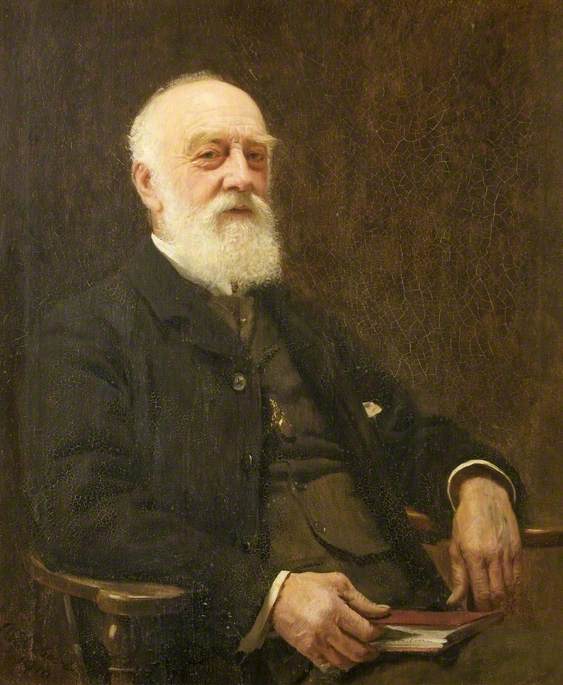
This portrait, painted in 1913, is a study in brown against which the head and hands of the sitter stand out with almost photographic clarity. Dr Wilson sits, not slumped but tired perhaps, in a low-backed Smoker’s Bow chair. It appears he’s been reading and has just looked up: the finger keeping his place at the right page suggests he’d like to get back to his book sooner rather than later. Behind their heavy lids his blue eyes hold the artist with a steady gaze. His hair, eyebrows and beard are painted with remarkable verisimilitude.
But a formal portrait this isn’t: the clothes Dr Wilson wears are comfortable rather than Sunday best, and the blank brown background gives no hint of his past profession or present standing. Perhaps the picture was commissioned by his family to mark his 80th birthday – a portrait of his wife was painted by the same artist, Alfred Usher Soord, at the same time. (Both portraits remained in the family until donated to the Cheltenham Art Gallery and Museum in 1978. Soord had previously painted Edward Adrian Wilson in 1910. This portrait hangs in the Scott Polar Research Institute, Cambridge.) Whether his necktie is, as the poet TS Eliot says of his diffident protagonist in ‘The Love Song of J Alfred Prufrock’, ‘rich and modest, but asserted by a simple pin’ we can hardly tell: the tie pin is all but invisible and the tie itself seems not so much tied round his Victorian high collar as tucked into his waistcoat. The only possible hint of show is his watchchain fob, a small gold locket hanging from a buttonhole.
The Doctor’s hands betray his age more clinically than his white hairs. His swollen knuckle joints suggest arthritis and the paper-thin skin of his left hand reveals both the grey veins beneath and the spots of ageing above. But his still-flexible thumbs are even more revealing. As any palmist could tell you, a thumb bending backwards as markedly as Dr Wilson’s left thumb does, even while his hand hangs limp, indicates an open and creative mind with a strong curiosity about the world. These are characteristics that fit artists and scientists equally, and ETW was both. Good portrait artists pay as much attention to hands as to faces. Soord, who was a highly respected artist in his day, has been careful to arrange the sitter’s hands so that only his flexible thumbs are shown in full; by contrast, the ends of all his fingers are hidden from the viewer.
The one thing this picture cannot tell you is that the sitter had lost his son, dead in a hut in Antarctica, only months – or possibly even weeks – before this portrait was begun. It took eight months to find the bodies of Scott, Wilson and Bowers; it is even possible that when Dr Edward Wilson first sat for Alfred Soord, he did not yet know what had become of his son. Realising this now, I find it hard to look at this portrait with the same detachment I brought to my first scrutiny of it.
Adrian Barlow
To see more artworks from The Wilson collection go to the Art UK website (click here) or The Wilson’s website (click here).
